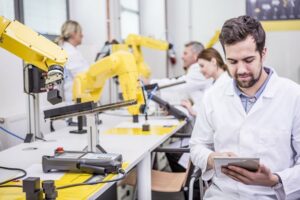The increase of connected equipment and IoT devices has forced Industry 4.0 to grow beyond cloud computing. In order to process the large amounts of data being collected by these devices in real-time, we have turned to Edge computing. Cloud computing has allowed us to offload compute nodes at the expense of bandwidth, but as connected devices increase, latency increases as well. Edge computing relocates the compute nodes closer to the source of data to reduce bandwidth and latency allowing a faster response time for devices relying on this information.
Hardware and Software for Edge Infrastructure
The edge infrastructure is unique for each application of a solution. This is largely based on the programmers determining what data needs to be processed locally and quickly along with distribution of the raw and processed data. Linux is an open-source environment that has modules to assist developers in creating edge infrastructure and applications. Applications must be developed for each device in the compute node in order to correctly route the appropriate information. Edge computing is also dependent on the processing power of the nodes intended to process data.
Consider the application of edge computing within a drone aerial show. If the drones used in the show are built on low power Arduino boards, they may not have the computer power to process location and reference information locally, which would require them to send data to a ground control system causing latency for flight path corrections. A drone built on the EMB-2237-AI would have more processing power and be able to processing location and reference information locally to the drone and make its own flight pattern corrections automatically with no latency.
The draw to Linux to build these environments is the flexible nature of the operating system and exchangeable technologies engineers and software developers use to create solutions. The future-proof nature of Linux allows a consistent and familiar working environment for programmers and provides the flexibility of multiple programming languages. Speed of innovation is a driving force in product development which is supported by a large adoption of community support for Linux development.
Linux Tablet PCs and Panel PCs Critical for Edge Computing Industries
The healthcare industry and robotic automation are two industries adopting Edge computing at a rapid pace. This is expedited by their acceptance of the Linux operating systems and the advantages that it brings to their industry. The free and open source nature of the operating system eliminates expensive licensing fees for employee workstations and system controls which can add up to huge expenses for large companies with widespread deployment
Linux at the Edge in Healthcare

The healthcare industry is one of the largest industries to embrace the use of Linux powered medical devices. Linux-based medical grade tablet PCs with antimicrobial chassis and enhanced security options such as fingerprint readers, smartcard readers and barcode scanners are an ideal solution for a variety of healthcare computing applications. Many hospitals and healthcare facilities are increasingly using Linux-based, custom software solutions that can support specialized medical applications. Linux powered tablets or panel PCs are more easily configured by OEM/ODMs to work with any healthcare provider’s specific software demands.
IoT devices in the medical field, such as wearables and monitoring devices, can play an important role in the industry when computing at the edge. Devices that collect data that must be acted on immediately will rely on localized processing to avoid the latency associated with uploading information to the cloud. Intensive care units and sophisticated sensors will need to be connected to networks with fail-safes and no down-time. Utilizing the Linux operating system to develop applications and infrastructure to process this data at the edge can also create an advantage in emergency medical services. While data is being processed and acted on locally at the edge, it can also be transmitted to hospitals to provide information on incoming patients.
Manufacturing and Automation Relies on Linux for Edge Computing

Linux can be completely customized and/or stripped down to fit specific use applications. It offers the flexibility to develop just about anything for an industrial, standards-compliant computing platform. Industrial Panel PCs with Linux are already widely used and adopted in manufacturing environments. Edge computing expands the localized processing power of these units to reduce bandwidth usage and reliance on core off-site controls. The edge platform can support interoperability for a larger mix of hardware and software, allowing easier integration with new components.
As more machines are added and new technology advances are integrated, scalability and programming becomes vital for the sustainment of the platform. Linux offers the necessary environment for a long life cycle for edge application development. Robust hardware, such as the PPC-4607, combined with the versatility of Linux helps bolster a rapidly developed solution for edge computing needs. It is important to consider hardware, software and connectivity in an edge solution.
